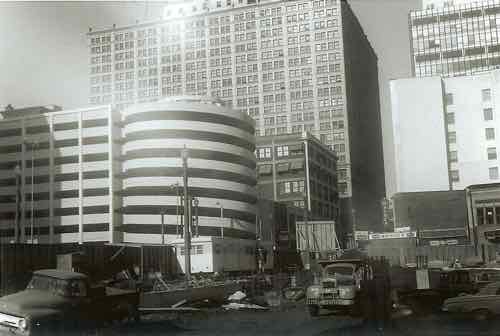Open Letter to the new Downtown Partnership President Maggie Campbell
This post is to welcome Maggie Campbell to St. Louis. Campbell started work yesterday as the new President and CEO of the Partnership for Downtown St. Louis. The following is from a September 30th St. Louis Business Journal article:
Campbell has been president of the Arlington (Texas) Downtown Management Association since 2006.
She will succeed Jim Cloar on Nov. 2 and become the first woman to hold the post, according to Shuntaé Shields Ryan, a Partnership spokeswoman.
Cloar announced his retirement plans in February after eight years at the helm.
Prior to her current position, Campbell served as president and CEO of the Old Pasadena Management District in Pasadena, Calif., and as executive director of the Dallas West End Association, a nonprofit organization that represents 24 blocks in the downtown Dallas historic entertainment district.
So now that everyone knows who I’m talking about I’m going to address the balance to her:
I’ve been a downtown resident for two years now. Even before I moved downtown I saw the potential. I remember going on tours of future lofts in the mid-1990s. Those never materialized but many others did. Over my 19 years in St. Louis I’ve seen far to many great buildings razed. I’ve seen some bad ones razed, but we still have too many of those.
I wanted to bring you up to speed on a variety of issues, giving you a different perspective that you probably won’t hear from the suits.
Busch Stadium:
- Seems to work well in downtown.
- Fans hang out before and after the game.
- Openness of the stadium is nice.
- Not paid for yet so I don’t expect changes for a long time.
- Two parking garages left over from previous Busch Stadium are horrible at the sidewalk level. Retrofit of street-level retail not feasible. Both garages need to go.
Ballpark Village:
- Good potential, good location.
- Cordish/Cardinals should create form-based standards and parcel out the land so that it can be built in stages by various entities.
Edward Jones Dome:
- Horrible structure that divides downtown from the near North side of town.
- Keep the Rams in the St. Louis region, just not downtown and probably not in the City of St. Louis.
- We should not invest more in the dome to meet the 2015 lease requirements.
Taxi stand at America’s Center:
- We have taxi cabs parking and driving on the public sidewalk where we have visitors to our city.
- Solution: move taxi stand to curb lane of Washington Ave.
Street Vendors:
- St. Louis’ current law is highly restrictive — too few licenses are issued.
- The area where licenses are issued is too small.
- Vendors are a great & cheap way to add life to sidewalks.
Parking (Bicycles):
- A handful of blocks on Washington Ave have some poorly placed bike racks.
- The rest of downtown mostly lacks bike parking.
Parking (On-Street):
- Every block needs to be evaluated to see where additional spaces can be added.
- Disabled parking needs to be added at metered spaces throughout downtown.
Parking (Garages):
- We have an excess number of garages although the suits will tell you we need more.
Bottle District:
- Not really a district, just vacant land North of the dome.
- Needs to be connected to adjacent areas.
Streets & intersections:
- 3-4 years ago a study was prepared that indicated some of our one-way streets could return to two-way traffic. I say make all two-way.
- Pedestrian signals downtown are lacking.
- We need to change the name of Convention Plaza back to Delmar.
Downtown guides:
- This may be happening already but get some of then off the bikes and on foot instead. They are more approachable on foot.
- The ones on bikes please make sure they actually secure their helmets.
- Make sure all shirts and jackets no longer say “CID” on the back because most don’t know that means Community Improvement District.
Arch Connection:
- The suits want to put the highway into an expensive 3-block long tunnel.
- They call the tunnel a lid so it sounds less expensive than it will be.
- A group of citizens has proposed a 2 mile long boulevard to replace the highway from Cass Ave to the Poplar Street Bridge.
- Connecting 2 miles is better than 3 blocks.
St. Louis Centre/skywalks:
- The failed downtown indoor mall.
- Walkways over the sidewalks on all sides.
Union Station:
- Not well connected to surrounding blocks.
- Needs residential closer.
22nd Street Interchange:
- Left over from a planned highway that is officially dead.
- Paul McKee plans to develop the area.
- Needs the restoration of the street grid.
- Possibly abandon highway connection here and build new interchange at Jefferson Ave.
Valet Parking:
- A few years ago numerous restaurants had out of control valet service.
- City needs a good way to permit and manage the valets so they conduct their business in a limited zone, leaving the rest of the street for the public.
Gateway Mall:
- Very long history, most of it not so good.
- Downtown has too much open space and not enough urban space. Leave the mall but build out other areas to reduce total open space.
- Citygarden is amazing. But many more blocks are awaiting a transformation.
- 1st priority is to extend the wide “hall” along the North side of Market St.
I’m sure I’ll think of other things but this is a good starter list. Readers will no doubt leave additional items in the comments. Many will disagree with me as well. This shows you that citizens care about downtown and that not everyone agrees. When the suits tell you something be sure to ask citizens what they think. Your members do not represent the typical resident or downtown user.
We’ve already met virtually but I look forward to meeting you in person. Welcome to St. Louis.
– Steve Patterson



